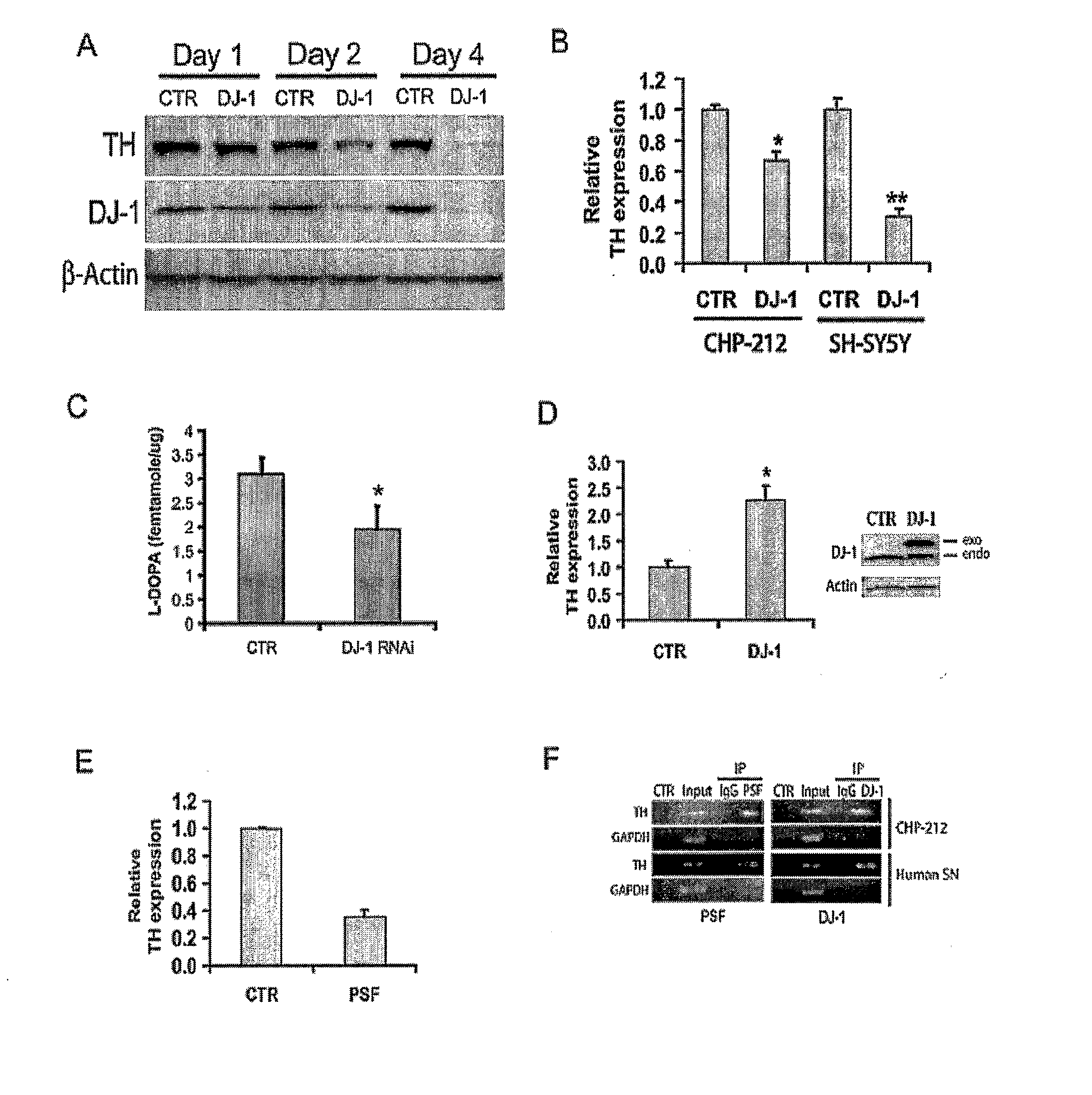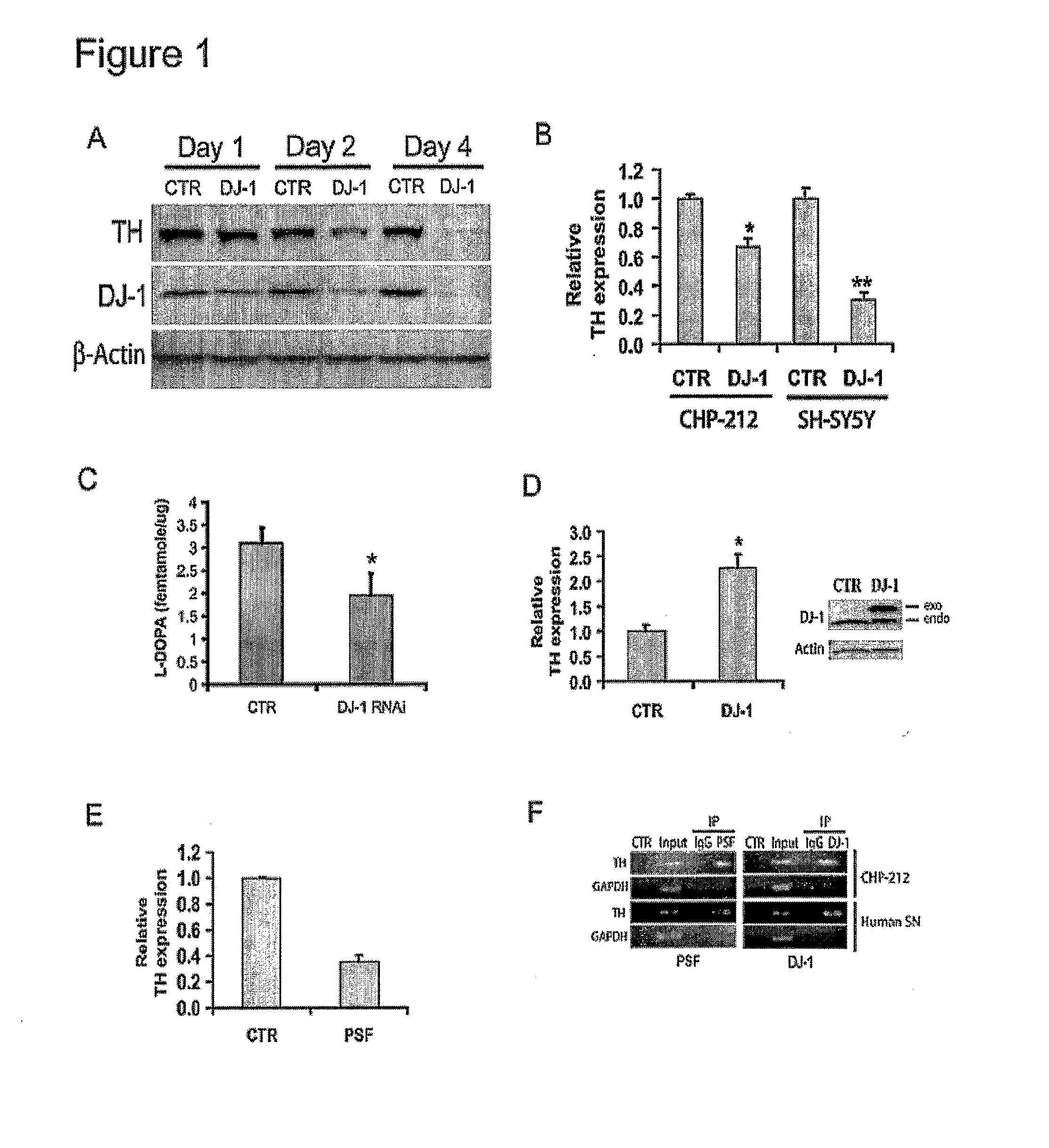Use of Androgens for the Treatment of Parkinson's Disease
a parkinson's disease and androgen technology, applied in the field of parkinson's disease androgens for the treatment of the disease, can solve the problems of oxidative stress, death, and drug side effects, and achieve the effects of reducing oxidative stress, and reducing neuronal cell death
- Summary
- Abstract
- Description
- Claims
- Application Information
AI Technical Summary
Benefits of technology
Problems solved by technology
Method used
Image
Examples
example 1
DJ-1 and PSF Transcriptionally Regulates the Human Tyrosine Hydroxylase Promoter
[0110]DJ-1 is a transcriptional co-activator. To determine whether DJ-1 regulated the expression of genes involved in dopaminergic neurotransmission, such as tyrosine hydroxylase, the rate-limiting enzyme that converts tyrosine to the dopamine precursor L-Dopa, DJ-1-specific siRNA constructs were used to inhibit the synthesis of endogenous DJ-1 in two human dopaminergic neuroblastoma cell lines, CHP-212 and SH-SY5Y cells. Expression of the DJ-1-specific siRNA mimicked the loss-of-function effects seen in Parkinson's disease patients with DJ-1 mutations. The protein levels of tyrosine hydroxylase and DJ-1 showed time-dependent decreases in CHP-212 cells transfected with DJ-1-specific siRNA (FIG. 1A). Four days after DJ-1 siRNA transfection, tyrosine hydroxylase protein expression was reduced by 90% (FIG. 1A). Quantitative real-time PCR results indicated that DJ-1 inactivation by siRNA significantly decrea...
example 2
DJ-1 Promotes Histone Acetylation
[0112]To explore the mechanism whereby DJ-1 upregulates the human tyrosine hydroxylase promoter, a potential role of DJ-1 in histone acetylation was examined, particularly the histones associated with the human tyrosine hydroxylase promoter. Increased acetylation of nucleasomal histones is known to promote gene expression. CHP-212 cells were transfected with DJ-1-specific or control siRNAs (FIG. 2). ChIP assays were then performed with antibodies that specifically recognize acetylated histones, and amplify the tyrosine hydroxylase promoter sequences using semi-quantitative PCR. Consistent with the concurrent inhibition of tyrosine hydroxylase (not shown), DJ-1 inactivation resulted in decreased acetylation of the tyrosine hydroxylase promoter-bound histones (FIG. 2).
example 3
Androgen Receptor Interacts with DJ-1 and Transcriptionally Activates the Human TH Promoter
[0113]DJ-1 transcriptionally activates the human tyrosine hydroxylase promoter in a human dopaminergic neuroblastoma cell line (CHP212) by blocking the repression by PSF49. Given that DJ-1 acts as a positive regulator of androgen receptor (AR)50,51, and that PSF binds one of the activation domains of androgen receptor52, androgen receptor may regulate the expression of the human tyrosine hydroxylase promoter and DJ-1 may act as a co-activator. The expression of androgen receptor and the interaction between androgen receptor and DJ-1 was examined in native CHP212 cells. Consistent with ChIP results described above, co-immunoprecipitation experiments also indicated that DJ-1 interacted with endogenous androgen receptor in native CHP-212 cells (FIG. 3A). In addition, like DJ-1, the androgen receptor specifically bound the human tyrosine hydroxylase promoter not only in CHP-212 cells, but also in ...
PUM
| Property | Measurement | Unit |
|---|---|---|
| Cell death | aaaaa | aaaaa |
| Stress optical coefficient | aaaaa | aaaaa |
Abstract
Description
Claims
Application Information
 Login to View More
Login to View More - R&D
- Intellectual Property
- Life Sciences
- Materials
- Tech Scout
- Unparalleled Data Quality
- Higher Quality Content
- 60% Fewer Hallucinations
Browse by: Latest US Patents, China's latest patents, Technical Efficacy Thesaurus, Application Domain, Technology Topic, Popular Technical Reports.
© 2025 PatSnap. All rights reserved.Legal|Privacy policy|Modern Slavery Act Transparency Statement|Sitemap|About US| Contact US: help@patsnap.com



